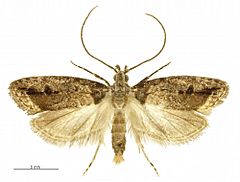Izatha facts for kids
Quick facts for kids Izatha |
|
|---|---|
 |
|
| Izatha caustopa | |
| Scientific classification | |
| Kingdom: | |
| Phylum: | |
| Class: | |
| Order: | |
| Family: |
Oecophoridae
|
| Subfamily: |
Oecophorinae
|
| Genus: |
Izatha
Walker, 1864
|
| Species | |
|
See text. |
|
| Synonyms | |
|
|
Imagine tiny, beautiful creatures that fly around at night! The Izatha moths are a special group of these insects. They are often called lichen tuft moths because of their unique look. You can only find these moths in one place in the whole world: New Zealand! This means they are endemic to New Zealand, like a secret treasure found nowhere else.
Contents
Meet the Izatha Moths
Izatha is a scientific name for a group of moths. This group belongs to a larger family called Oecophoridae. These moths are usually small. They often have patterns that help them blend in. This camouflage helps them hide from predators.
What Do They Look Like?
Izatha moths are known for their interesting patterns. Their wings can have spots, lines, or patches. These designs often look like the lichen and bark they live on. This helps them stay hidden during the day. The moths are usually a mix of browns, greys, and whites.
Where Do They Live?
Since Izatha moths are endemic, they live only in New Zealand. They can be found in different habitats there. This includes forests, shrublands, and even gardens. They often live near trees and plants. This is where they find their food and lay their eggs.
Species of Izatha Moths
Scientists have discovered many different kinds of Izatha moths. Each kind is called a species. There are over 30 known species in this group. Scientists often group similar species together. This helps them study and understand the moths better.
How Scientists Group Them
Scientists group Izatha species into smaller categories. These groups are based on how the moths look. They also look at their DNA and other features. For example, some groups are named after a well-known species within them. This helps keep track of all the different types.
- The attactella-group includes species like Izatha attactella.
- The mira-group has species such as Izatha mira.
- The apodoxa-group contains moths like Izatha apodoxa.
- The balanophora-group is a larger group. It includes species like Izatha balanophora.
- The oleariae-group features moths like Izatha oleariae.
- The caustopa-group includes Izatha caustopa.
- The convulsella-group has species such as Izatha convulsella.
Each of these species is unique. They might have slightly different patterns. They might also live in specific parts of New Zealand.
Life Cycle of Moths
Like all moths, Izatha moths go through a metamorphosis. This means they change completely. They start as an egg. Then they hatch into a larva, which is a caterpillar. The caterpillar eats and grows.
From Caterpillar to Moth
After growing enough, the caterpillar forms a pupa. This is like a resting stage. Inside the pupa, the caterpillar changes. It transforms into an adult moth. Finally, the adult moth emerges. It then flies, mates, and lays eggs. This completes the life cycle.
Why Are Moths Important?
Moths play an important role in nature. They can be pollinators. This means they help plants make seeds. They also serve as food for other animals. Birds, bats, and other insects eat moths. So, Izatha moths are a small but important part of New Zealand's ecosystem.

